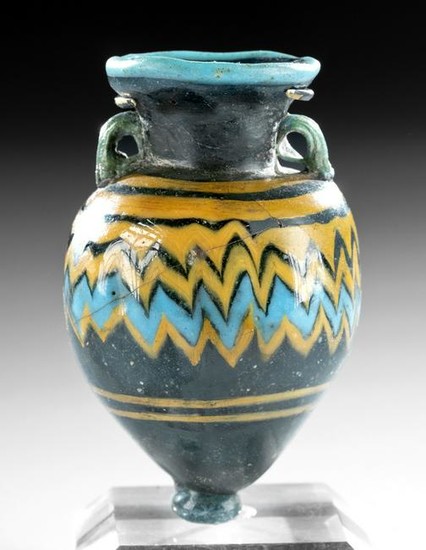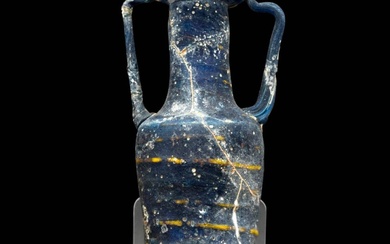Rare Greek Core Formed Glass Amphoriskos
**First Time At Auction**
Ancient Greece, ca. 6th to 4th century BCE. A very early example of a core-formed glass amphoriskos (miniature amphora) once used to hold perfumed oil. This near miniature vase boasts an exceptionally elegant form with an inverted piriform body that is finely contoured with subtly delineated vertical ribs, twin trailed handles that gracefully join the shoulder to the cylindrical neck, and a flared rim, all upon a trailed knob foot. The decoration of this piece is simply breathtaking. Note how the cobalt blue body is wound with aqua blue and golden tangerine thread-like trails applied in a close-knit zigzag or feathered pattern. Additional golden trails delineated as horizontal bands adorn the areas above and below the feathered pattern and an aqua trail encircles the rim. A divine work of glass art to be treasured for its impeccable form, beautiful hues, and sophisticated technique. Size: 2.25" H (5.7 cm); 3" H (7.6 cm) on included custom stand.
A vessel like this would have been made for the elites of ancient society. Its owner would have used a stopper to keep the contents inside, and a glass rod to dip into the vessel's perfumed oils and dab on the throat or wrists. The handles made it possible to suspend the vessel, and we know from Athenian vase paintings that vessels like these could be worn off a belt at the waist or suspended from the wrist.
The Greeks created core-formed or sand core vessels by trailing threads of molten glass over a "core" of sand or clay to form the vessel. These threads were oftentimes feathered or dragged to create intriguing decorative patterns. The term amphoriskos literally means "little amphora" and is indeed a miniature amphora. This shape was quite popular as it was ideal to store precious oils, perfumes, or cosmetics.
According to the Corning Museum of Glass, core forming is "the technique of forming a vessel by winding or gathering molten glass around a core supported by a rod. After forming, the object is removed from the rod and annealed. After annealing, the core is removed by scraping." (https://www.cmog.org/glass-dictionary/core-forming). This process of glass making was begun in the late 16th century BCE by glassmakers of Mesopotamia, and then adopted by Egyptian glassmakers in the 15th century BCE. The technique almost came to an end in the so-called Dark Ages of Mediterranean civilization (1200 to 900 BCE);however, by the 9th century BCE a new generation of glassmakers took up the technique once again, and between the 6th and 4th century BCE core-forming spread throughout the Mediterranean.
Provenance: The Dere Family Collection, New York, USA, assembled 1970's-2000's; ex-Martin J. Wunsch collection, New York, USA, acquired in the 1960s
All items legal to buy/sell under U.S. Statute covering cultural patrimony Code 2600, CHAPTER 14, and are guaranteed to be as described or your money back.
A Certificate of Authenticity will accompany all winning bids.
We ship worldwide to most countries and handle all shipping in-house for your convenience.
#147860
Condition Report: Repaired from 2 large pieces with restoration over the break lines. Small loss to shoulder may be a spall (mineral content that came through the surface). Overall, repairs are very well done.
View it on
Sale price
Estimate
Time, Location
Auction House
**First Time At Auction**
Ancient Greece, ca. 6th to 4th century BCE. A very early example of a core-formed glass amphoriskos (miniature amphora) once used to hold perfumed oil. This near miniature vase boasts an exceptionally elegant form with an inverted piriform body that is finely contoured with subtly delineated vertical ribs, twin trailed handles that gracefully join the shoulder to the cylindrical neck, and a flared rim, all upon a trailed knob foot. The decoration of this piece is simply breathtaking. Note how the cobalt blue body is wound with aqua blue and golden tangerine thread-like trails applied in a close-knit zigzag or feathered pattern. Additional golden trails delineated as horizontal bands adorn the areas above and below the feathered pattern and an aqua trail encircles the rim. A divine work of glass art to be treasured for its impeccable form, beautiful hues, and sophisticated technique. Size: 2.25" H (5.7 cm); 3" H (7.6 cm) on included custom stand.
A vessel like this would have been made for the elites of ancient society. Its owner would have used a stopper to keep the contents inside, and a glass rod to dip into the vessel's perfumed oils and dab on the throat or wrists. The handles made it possible to suspend the vessel, and we know from Athenian vase paintings that vessels like these could be worn off a belt at the waist or suspended from the wrist.
The Greeks created core-formed or sand core vessels by trailing threads of molten glass over a "core" of sand or clay to form the vessel. These threads were oftentimes feathered or dragged to create intriguing decorative patterns. The term amphoriskos literally means "little amphora" and is indeed a miniature amphora. This shape was quite popular as it was ideal to store precious oils, perfumes, or cosmetics.
According to the Corning Museum of Glass, core forming is "the technique of forming a vessel by winding or gathering molten glass around a core supported by a rod. After forming, the object is removed from the rod and annealed. After annealing, the core is removed by scraping." (https://www.cmog.org/glass-dictionary/core-forming). This process of glass making was begun in the late 16th century BCE by glassmakers of Mesopotamia, and then adopted by Egyptian glassmakers in the 15th century BCE. The technique almost came to an end in the so-called Dark Ages of Mediterranean civilization (1200 to 900 BCE);however, by the 9th century BCE a new generation of glassmakers took up the technique once again, and between the 6th and 4th century BCE core-forming spread throughout the Mediterranean.
Provenance: The Dere Family Collection, New York, USA, assembled 1970's-2000's; ex-Martin J. Wunsch collection, New York, USA, acquired in the 1960s
All items legal to buy/sell under U.S. Statute covering cultural patrimony Code 2600, CHAPTER 14, and are guaranteed to be as described or your money back.
A Certificate of Authenticity will accompany all winning bids.
We ship worldwide to most countries and handle all shipping in-house for your convenience.
#147860
Condition Report: Repaired from 2 large pieces with restoration over the break lines. Small loss to shoulder may be a spall (mineral content that came through the surface). Overall, repairs are very well done.




